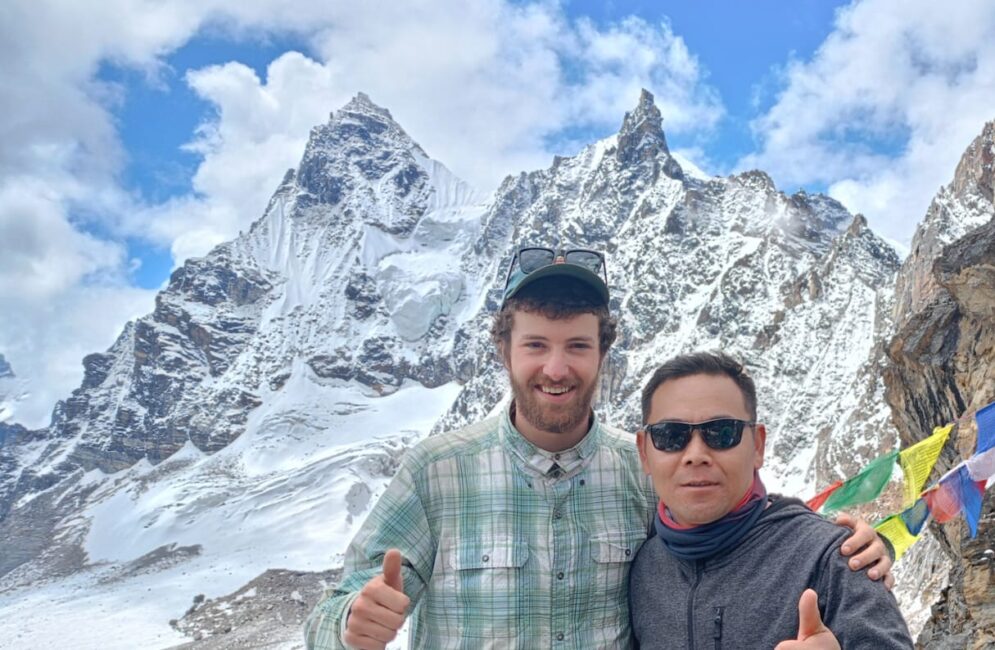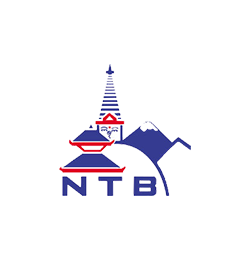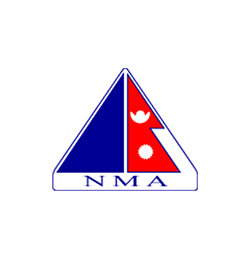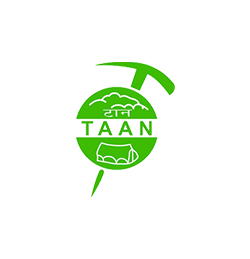
Everest Base Camp Trek Overview
The Everest Base Camp (EBC) Trek is one of the most iconic and challenging treks that the great Himalayas offer. It draws attention from all over the globe, with about 40,000 people trekking the trails each year. Being the base camp to Everest (8,849 meters), the highest peak in the world, EBC is perfect for seeing the grandeur of this great peak. At an altitude of 5,365 meters, the EBC is also regarded as one of the most challenging treks that take about 12 days to complete.
The journey begins in Kathmandu, the capital city of Nepal, from where trekkers reach Lukla. Reaching Lukla can be done by bus, but the most preferable way is to catch a short flight from Kathmandu to Lukla (40 minutes). This short flight is known to provide exhilarating views of the whole Khumbu region, giving you a hint of what comes in the next few days. From Lukla, trekkers pass through picturesque Sherpa villages, dense forests, and high-altitude terrains over the course of several days. Trekkers get rewarded with breathtaking views of snow-capped peaks including Everest, Lhotse, and Ama Dablam. All along the trail, the panoramic view of the Himalayas becomes a mesmerizing sight. This trek not only provides mesmerizing views but also is a great way to experience the unique culture and hospitality of the Sherpa people. As you conquer the base camp at 5,364 altitudes, you get covered with the Himalayas from all four sides, as the sense of accomplishment and love for nature takes over you.
The Everest Base Camp Trek is a perfect combination of nature, adventure, and cultural immersion, making it a famous choice for adventurers. For some, EBC has been a life-changing experience as they realize their connection with nature. The blooming rhododendron in spring adds to the beauty of Sagaramatha National Park, making the trail magical from the very first day. Slowly, as you progress on with the trail you experience the changing landscapes from lush forests to barren high-altitude deserts. The transition is so subtle that you fail to notice when the changes occur.
As beautiful as it sounds, Everest Base Camp is a really challenging trek, as you get past the 5000-meter mark. Trek with White Hill Adventure, and not only experience the magical Everest Base Camp Trail but also stay safe all the time. With White Hill Adventure, our primary motive remains your safety and a smooth experience. We take care of your permits, passes, visas, safety, and accommodation, and even provide customized itineraries for the best experience in the Himalayas.
Highlights
- Stunning panoramic views of Everest and surrounding peaks.
- Experience the unique Sherpa culture in villages like Namche Bazaar.
- Visit the historic Tengboche Monastery.
- Cross high suspension bridges over roaring rivers.
- Acclimatization hikes to viewpoints like Everest View Hotel.
- Diverse landscapes from lush forests to high-altitude deserts.
- Interact with fellow trekkers from around the world.
Best Season and Weather Climate
In the Himalayas, the weather is hard to navigate through. Even experts find it difficult to predict the weather, as it changes very fast. At such a high altitude choosing the perfect season to trek becomes essential to having a safe trek. Moreover, with the perfect season, you can get unobstructed views of the Himalayan region.
The best Season for Everest Base Camp Trek
- Spring Season- (March to May)/ Pre Monsoon
Spring season is the most favorable and preferred season for trekking. As the blooming Rhododendron paints the whole hills in shades of red and pink, the already beautiful trails get decorated with this beautiful flower. In spring the views are clear with crisp air, allowing for a great panoramic view. Moreover, the Spring season has the most stable weather resulting in fewer weather changes. The average temperature ranges from 10°C to 15°C, which is perfect for walking all day.
The downside to trekking in this season is the flow of trekkers is very high. Almost all the accommodation is pre-booked and the trails are filled with trekkers from all around the world. This may be troublesome for those who opt for a less crowded experience.
- Autumn Season – (September to November)/ Post Monsoon
Another best season for trekking is the autumn season. The temperatures remain mild with an average of -10°C to 15°C. The crisp air especially after the monsoon offers some of the clearest views of the great Himalayan region. The only downside when compared to the Spring season is the blooming rhododendron, which doesn’t bloom until early March. However, the positive side of trekking in this season is that the flow of trekkers is comparatively lower. The stable weather conditions make Autumn another great season to trek on.
Other Trekking Season
- Monsoon Season (June to August) and Winter (December to February)
In Monsoon, the trail is wet and slippery making it an unfavorable trekking time. The clouds cover the view most of the time, and the weather remains foggy throughout the Monsoon season. The risk for landslides and accidents is high during this season. Not recommended.
However, there are few cases when trekkers trek during the Winter Season, it is not a practical thing to do. There is a high level of snowfall in the high altitude, increasing the risk of avalanches and strong blizzards. Most of the time, the trail gets covered with snow, making it impossible to continue trekking. Moreover, the teahouses and accommodation services remain closed during this season.
Trails Details
Trekking the Everest Base Camp is not just about the view and the glorious mountains, the 12 days long trail takes you through a rollercoaster of emotions that makes this trek whole. The trail starts from Lukla as you follow through a well-marked trail through Phakding, Namche Bazaar, Dingboche, Lobuche, Gorak Shep, and finally to Everest Base Camp. Throughout these 12 days, trekkers traverse through diverse landscapes starting from lush green forests at lower altitude which then transitions to barren, and rocky terrain at higher altitudes
You also get to visit some key stops such as the Hillary Suspension Bridge, the famous Sherpa Museum in Namche Bazaar, Tengboche Monastery, and acclimatization to Everest View Hotel. The highest point of your trail will be at Kala Patthar (5555 meters), known to provide the most beautiful view of Everest over sunrise. Everest Base Camp is not only about the final moments, the small memories you make throughout the trail add to your journey to make EBC a once in a lifetime journey.
Difficulty Level
The Everest Base Camp Trek is considered one of the most strenuous treks in Nepal. Trekkers who undertake this trail must have a good level of fitness and some prior trekking experience. However, if you are a beginner and want to trek EBC, White Hill Adventure offers a carefully planned itinerary for you with the best guides primarily focused on helping beginners conquer this trek.
The main challenge for this trek is the altitude, as the base camp itself is at 5,364 meters and the highest point is the Kala Pathhar at 5,555 meters. The risk of altitude sickness and challenging weather prevails daily throughout the trek. Trekkers must walk 5 to 8 hours daily, covering approximately 10-15 kilometers. However, for acclimatization, most itineraries have 2 days, one in Namche Bazaar and the other in Dingboche. This helps you to acclimatize to the increasing altitude. The trek involves navigating rocky and sometimes icy terrain, making it physically demanding. However, difficult the EBC may sound, with proper knowledge and safety precautions, anyone with basic physical fitness can undertake this trek and experience the glory of Everest Base Camp.
Accommodations Details
Accommodations on Everest Base Camp Trek are primarily teahouses and lodges. When compared to other trekkers in Nepal, the EBC offers more cozy and luxurious accommodation services due to the high flow of tourists in the area. Rooms in teahouses are usually twin-sharing with communal bathrooms. While the amenities remain basic, the teahouse provides a warm bed, and meals to recharge you for the next day.
In lower altitude, especially Namche Bazaar you get an option for more luxurious stays and meals. With private bathrooms, and hot showers that come with additional fees, Namche Bazaar is the tourist hub of the whole Khumbu region. As you ascend your trail, the facilities become more basic with shared toilets and limited meal options. Despite the simplicity, the hospitality of the tea house owners is heartwarming, and the dining areas are often cozy with a wood-burning stove.
Food and Restaurants
When compared to other treks in Nepal, the food and restaurants throughout the trails are quite good. With local and international dishes served in lower altitudes, checkpoints like Namche Bazaar offer lavish bakeries and cafes for you to hang out. But most of the time you’ll spend nights in teahouses and dine there. Mostly, you get the options for traditional Dal Bhat (rice and lentils), noodles, dumplings (momos), and soups. These local cuisines are packed with nutrition providing the necessary energy for trekking.Breakfast in these teahouses typically includes pancakes, porridge, and eggs. As you ascend in your trail, the menu becomes more limited and prices increase due to the difficulty of transporting goods at such altitude. It is advisable to try local Sherpa dishes for a unique culinary experience. Sherpa’s diet typically consists of Shakpa, Thukpa, Kur (Tibetian Bread), and Rildok.
The teahouses on these trails are far from each other, sometimes even 5-6 hours. All along the way you get no supplies, so it is recommended to carry snacks for your way. Snacks rich in nutrition and sugar such as Snickers, Nuts, protein bars, and jerky are some great options to provide you energy throughout the trail.
Safety and Emergency Procedure
Safety during Everest Base Camp is the most essential aspect. With Nepal’s new law passed it is compulsory for trekkers to have a certified guide with them. This law was passed for the safety of trekking in high altitudes. Having a trustworthy guide not only increases your safety throughout the trail but also provides valuable insights all along the trail, enriching the overall experience of the trek. For that, White Hill Adventure offers some of the best trekking guides with years of experience and a good knowledge of Himalayan terrain and weather.
Altitude Sickness becomes a major problem while trekking at higher altitudes like Everest Base Camp. It is crucial to acclimatize properly and recognize symptoms such as headaches, nausea, and dizziness. Drinking plenty of water, staying hydrated, and proper acclimatization can help overcome altitude sickness. If symptoms worsen, it is recommended to descend to lower altitudes and stop ascending.
In case of emergencies, agencies like White Hill Adventure provide oxygen and altitude chambers, but continuing your trek by depending on these features may not be a wise idea. Moreover, in severe cases, the trekkers can also be rescued via helicopter but the charges are very high. We recommend trekkers be safe and follow safety protocols given by the trekking agency for a smooth and safe trekking experience.
Culture, Wildlife, and Nature
The Everest Base Camp trek lies in the Sagarmatha National Park, known for its unique Sherpa culture and mesmerizing flora and fauna. The whole of Khumbu region is inhabited by the Sherpa people, known for their mountaineering skills and warm hospitality. Throughout the trek, you spend nights in teahouses where you get to connect with local Sherpa families and understand their way of life. Try their cuisine and share stories over a warm meal.
The trail to EBC is dotted with temples and stupas all along, adding a spiritual value to this trek. Trekkers get to visit the Tengboche Monastery, a key cultural site famous for Buddhist rituals and cultural practices.
The Sagarmatha National Park is a UNESCO World Heritage site, known for its diversity of flora and fauna. Lucky people can also get a glimpse of rare animals such as Himalayan Tahr, musk deer, and the rare snow leopard. The whole region is covered with rhododendrons and in peak seasons of Spring, the hills get painted in transitioning hues of red, pink, and white. The natural beauty when combined with cultural richness makes Everest Base Camp a combination of emotions and experiences.
The Everest Base Camp Trek offers an immersive experience of the Sherpa culture. The Sherpa people, known for their mountaineering skills, are warm and hospitable. Key cultural sites include the Tengboche Monastery, where trekkers can witness Buddhist rituals and enjoy panoramic views of the Himalayas. The region is also home to diverse wildlife such as the Himalayan Tahr, musk deer, and the elusive snow leopard. The trek passes through Sagarmatha National Park, a UNESCO World Heritage site, featuring lush forests of rhododendron, pine, and fir at lower altitudes and alpine meadows and glaciers higher up. The natural beauty, combined with cultural richness, makes the trek an unforgettable experience.
Trekking Preparation Tips
Proper preparation is crucial for the success of Everest Base Camp. A trek that takes you above 5000 meters and spans 12 days or more should require a good focus on training. Physical fitness plays an important role while trekking in high altitudes, so beginning physical training at least three months in advance is recommended. Walking at high altitude for 5-8 hrs per day is not an easy task, so you must focus on cardiovascular fitness, strength, and endurance to cope with the demanding nature of this trek.
Acclimatization days become the most crucial for your trek, so plan accordingly or increase acclimatization days if you need to. Pack wisely depending upon the season you choose. Thermal clothing, good sleeping bags, trekking poles, and high-quality trekking boots are a must. Don’t forget essentials such as the first aid kit, water purification tablets, and high energy snacks. Learn about possible dangers including High Altitude Sickness, their symptoms, and prevention. Moreover, aside from Physical preparations, Mental preparation is also important as you need to be ready for challenging days and fluctuating weather.
Photography Opportunity
The Everest Base Camp Trek provides unparalleled photography opportunities. The crisp air of the Himalayas provides some of the clearest and highest-quality photos. All along the trail, the views are amazing and give you a good chance for a great photo. Key spots like Namche Bazaar, with its vibrant market and stunning mountain background, and the Tengboche Monastery set against majestic peaks are not to be missed. The ascent to Kala Patthar is known to provide some of the best views of Everest, Lhotse, and Nuptse (especially during sunrise and sunset)
The Khumbu Glacier and Icefall are another dramatic scene that makes for a great photograph. All along the way, capture the traditional Sherpa villages, with prayer flags fluttering in the wind. Ensure your camera is well protected against the cold, especially in higher altitudes, where options for charging can be limited. Thus, it is recommended to carry additional batteries in case of emergencies.
FAQs
-
How much additional money should I plan to have on hand during a trek?
Predicting the perfect amount of money required for the trek is a hard job. After booking a trip via White Hill Trekking, almost everything is covered by the team. Moreover, you should plan for an additional $20-$30 per day for meals, snacks, and other personal expenses.
-
Do I need a permit for the Everest Base Camp Trek?
Yes, you’ll need a permit to enter the Sagarmatha National Park, and also a TIMS card that is compulsory for trekking any trails inside Nepal.
-
What is the best time of year to trek to Everest Base Camp?
The best times to trek the Everest Base Camp are pre-monsoon (March to May) and post-monsoon (September to November).
-
How difficult is the Everest Base Camp Trek?
Everest Base Camp is a strenuous trek that takes you a max altitude of 5,545 meters at Kala Patthar. Moreover, with about 5-8 hours of walking per day for about 2 weeks, the difficulty level is high.
-
Can I trek to Everest Base Camp solo?
Yes, solo trekking to Everest Base Camp is very much possible, but hiring a guide is recommended for safety and navigation.
-
What kind of food is available on the trek?
Mostly you get served traditional Nepalese cuisine that includes Dal Bhaat (rice and lentils), and some teahouses may also offer noodles, pancakes, and other international cuisine.
-
Is altitude sickness common?
Yes, altitude sickness is very common while trekking the Everest Base Camp. Going past 3000 meters above sea level is where most people start showing symptoms.
Yes, it is common; acclimatization days are essential to reduce the risk.
-
What type of accommodation is available?
Mostly, the accommodation services are teahouses and lodges throughout the trek. This accommodation provides you with basic facilities for spending the night.
-
Do I need travel insurance for the trek?
Yes, travel insurance is very much recommended for this trek. Make sure to ensure that the insurance covers high-altitude trekking and emergency evacuations.
-
How many days does the trek take?
The trek itinerary typically consists of 12-14 days. You can always get a personalized experience with White Hill Adventure.
-
Is it possible to charge electronic devices?
Yes, at lower altitudes you can charge your electronics, but they do come with an extra price tag.
-
Are there communication facilities on the trek?
At higher altitudes, past 300 meters there’s limited Wi-Fi and mobile networks available. They do come with an extra price tag.
Solo Traveler and Group Options
Solo Travelers have their separate vibe, the freedom and flexibility of trekking alone is a wonderful experience. But for Everest Base Camp it is advisable to hire a guide for safety and navigation. Hiring a guide comes with many advantages, guides from White Hill Adventures offer you insights throughout the trail, enriching the overall experience. Moreover, a guide also keeps you safe and navigates you through challenging terrain.
Trekking with groups creates another dimension of experience. Trekking the Everest Base Camp with your loved ones is a great way to strengthen the relationship and make memories that last a lifetime. Moreover, group trekking is also economical as costs for guides, and porters, can be shared making it the most favorable thing to do.
Personalize Support, Customer Care, and Responsible Tourism
With different people trekking the Everest Base Camp Trek, each one of them needs a tailored itinerary for the best experience. Trusted trekking agencies in Nepal offer personalized support that caters to the specific needs of trekkers and hikers all around the globe. Agencies like White Hill Adventure have been serving trekkers by helping them create personalized itineraries for years now. This includes customized itineraries, dietary considerations, special permits, acclimatization days, and many more.
Customer care becomes another essential thing that most trekking agencies provide. Providing briefings before the trek, 24/7 support during the trek, and feedback sessions after the trek. White Hill Adventure is always by your side. You can reach us via our 24 hrs costumers support number.
As the number of trekkers in Nepal increases yearly, practicing responsible tourism is a must. Minimizing plastic use, respecting local cultures, and ensuring fair wages for guides and porters often help sustain a good trekking culture. Trekking Agencies often collaborate with local communities to support education and organize cleaning campaigns, and conservation efforts to ensure that tourism sustains the region.
Guide Certifications and Experience
With the increase in tourism in Nepal, the number of trekking agencies has gone up rapidly. With this, it is becoming hard to find a reliable trekking agency that provides excellent guides. Qualified guides are a must for a safe trekking experience. Certified guides have gone through harsh training and are knowledgeable about the terrain. These guides are experts in predicting weather conditions and are also familiar with emergency procedures.
They are often accredited by the Nepal Mountaineering Association and other trekking associations. Experienced guides are a great way to ensure your safety and enrich your overall experience of the trek. They are full of knowledge about culture, trails, and things not to miss on the trail. They are expert at managing the group’s pace and ensuring proper acclimatization stops. With White Hill Adventure you get guides who have experience in trekking for more than 10+ years, all certified by the highest recognizable associations nationally and internationally. We offer guides with excellent communication skills and track records of successful treks.
Detail Itinerary
Day 1: Flight from Kathmandu to Lukla (2,860m) – 35 minutes; Trek to Phakding (2,610m) – 3-4 hrs.
From Kathmandu, catch a mesmerizing flight to Lukla, then start your trek along the glorious Dudh Koshi River to reach Phakding. You pass through picturesque villages that offer a glimpse of local life.
Day 2: Phakding to Namche Bazaar (3,440m) – 5-6 hrs.
Early morning, start your day as you move towards Namche Bazaar, a bustling hub of the whole Khumbu region. Cross-suspension brides and with a steep ascent reach Namche Bazaar. This small town has shops, restaurants, and internet cafes.
Day 3: Acclimatization day in Namche Bazaar.
Acclimatization is essential during Everest Base Camp. Hike to Everest View Hotel for great panoramic views of Everest and neighboring peaks. Return back to Namche Bazaar.
Day 4: Namche Bazaar to Tengboche (3,860m). 5-6 hrs
The trails get more beautiful as you trek towards Tenboche. Offering spectacular views of the mountain vistas. Visit Tenboche Monastery, the spiritual center of the Khumbu region.
Day 5: Tengboche to Dingboche (4,410m). 5-6 hrs
Trekking to Dinboche from Tenboche is a rough job. You cross the Imja Khola and pass through lush rhododendron forests. Reaching Dingboche you get a chance to acclimate and rest.
Day 6: Acclimatization day in Dingboche.
A second acclimatization day in Dingboche as the next few days, you will move to higher altitudes. You can organize short hikers to nearby ridges and explore the village.
Day 7: Dingboche to Lobuche (4,940m). 5-6 hrs
The trail to Lobuche is full of steep climbs and views of the Khumbu Glacier. You pass through memorials for the climbers who lost their lives in Everest. Paying your respect you move on to Lobuche.
Day 8: Lobuche to Gorak Shep (5,170m), then to Everest Base Camp (5,364m), and back to Gorak Shep. 7-8 hrs
A challenging day as you trek to Gorakh Shep, and the continue to Everest Base Camp. Reaching Base Camp, you make memories and take in the beauty of the glorious Everest Region. After spending a few hours in the base camp, you move back to Gorak Shep.
Day 9: Gorak Shep to Kala Patthar (5,545m), then to Pheriche (4,371m). 5-6 hrs
Early morning ascent to Kala Pathhar, known to provide some of the most beautiful views of Everest. As the rays of the sun paint this great mountain, your heart melts and forgets all the pain it ever had. You descend back to Pheriche.
Day 10: Pheriche to Namche Bazaar. 6-7 hrs
The descent officially starts as you get back to Namche Bazaar. Mostly a downhill trek, but still demands caution and energy.
Day 11: Namche Bazaar to Lukla. 6-7 hrs
Retracing your steps to Lukla, you exit the Sagarmatha National Park where the trek officially ends. Spend the night celebrating and summarizing the trip.
Day 12: Flight back to Kathmandu.
Early morning flight back to Kathmandu, with the same mesmerizing aerial view of the Whole region. You return with a heart filled with memories that will last a lifetime. The adventure ends.
Cost Information
Cost Includes
- Both way flight tickets (Kathmandu-Lukla-Kathmandu).
- All meals (Breakfast/Lunch/Dinner) during the trek.
- All mountain accommodation/lodges.
- Sagarmatha National park fee and Trekking Permit.
- English speaking, trained and experienced trekking Guide.
- Guide costs including his salary, equipment, insurance food and accommodation.
- First AID and Medical Kit
- International and Domestic airport Pick up and Drop service.
- All Government tax and Service Charge.
Cost Excludes
- Your Personal Trekking Equipment (Note: Equipment can be rented in Kathmandu, Nepal)
- Your personal Travel Insurance.
- Personal Expenses (Beer, Cola, Laundry Service, Phone Calls, Battery Charges, Bar bills, Hot Shower Boiled water, etc.)
- Porter (25 USD Per day).
Equipment
White Hill Adventure Treks and Expedition will send necessary equipment for different kind of activities in Nepal. High altitude trekking activities might require these lists for smooth trekking in the Himalayan region.For Head
- Sun hat / Scarf
- Sunglasses and Headlight
For Upper Body
- Water Proof Jacket
- Down Jacket / Warm Jacket
- Light Weight T-shirt (At least 1 pair)
For Lower Body
- Water Proof Pants
- Running tights
- Light Weight Pant
For Hand
- Gloves
For Feet
- Thin Inner socks (At least 2 pairs)
- Woolen socks
- Trekking boots (preferred comfortable boots)
Other Accessories
- Sleeping bag
- Water bottle etc
- Suncream
- Water purification tablets
- Toiletries (Toilet paper etc)
- Warm hat
- Trekking Bag Etc.
Reviews
13 Reviews to “Everest Base Camp Trek”
Write a Review
Outline Itinerary
Day 1: Flight from Kathmandu to Lukla (2,860m) – 35 minutes; Trek to Phakding (2,610m) – 4-5 hrs.
Day 2: Phakding to Namche Bazaar (3,440m) – 5-6 hrs.
Day 3: Acclimatization day in Namche Bazaar.
Day 4: Namche Bazaar to Tengboche (3,860m) – 5-6 hrs.
Day 5: Tengboche to Dingboche (4,410m) – 5-6 hrs.
Day 6: Acclimatization day in Dingboche.
Day 7: Dingboche to Lobuche (4,940m) – 5-6 hrs.
Day 8: Lobuche to Gorak Shep (5,170m), then to Everest Base Camp (5,364m), and back to Gorak Shep – 7-8 hrs.
Day 9: Gorak Shep to Kala Patthar (5,545m), then to Pheriche (4,371m) – 7-8 hrs.
Day 10: Pheriche to Namche Bazaar – 6-7 hrs.
Day 11: Namche Bazaar to Lukla – 6-7 hrs.
Day 12: Flight back to Kathmandu.







What a fantastic trip with cultural and heritage tour around Kathmandu with a scenic flight to Lukla which was on time. I joined with White Hill Adventure Treks for Everest Base Camp throughout the trip and trekking was a great experience with delightful moments. From Kathmandu Hotel accommodations to transportation and Everest base camp trekking organized with expert and professional services as promised. White Hill staff and guide supported me in every way from the start to the end of the trek. I am coming back for another adventure and joining with White Hill Adventure again. Thanks for everything!
Amazing and fantastic times on Everest Base Camp Trekking in the comfort of nice lodges on route with warm friendly services of White Hill Adventure cheerful and friendly guide and staff. I got all the money-worth of services and quite surprised as well with great knowledge of White Hill guides providing full information of Everest areas its
culture, religion including flora and fauna. Truly the best local company to travel and worth it, I recommend White Hill Adventure to all my friends and family. Thank you White Hill Adventure offering great excellent services.